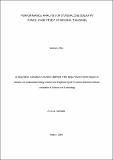| dc.contributor.author | John, Nickson | |
| dc.date.accessioned | 2019-05-31T07:34:57Z | |
| dc.date.available | 2019-05-31T07:34:57Z | |
| dc.date.issued | 2019-03 | |
| dc.identifier.uri | https://doi.org/10.58694/20.500.12479/280 | |
| dc.description | A Dissertation Submitted in Partial Fulfillment of the Requirements for the Degree of Master’s in Sustainable Energy Science and Engineering of the Nelson Mandela African Institution of Science and Technology | en_US |
| dc.description.abstract | The purpose of this study was to carry out experimental and theoretical performance analysis of standalone solar Photovoltaic (PV) panel in tropical region. The study concentrated on the influence of poor PV panel positioning especially on the gap between the PV and roof, simulation, and over-shading. Three polycrystalline silicon panels of 100 watts each were selected from different manufacturers in local market. The panels were placed on a simple developed structure of corrugated metal sheet (CMS) roof; solar irradiance, gap between roof and PV panels, and temperature of the panels were the parameters affecting the PV system performance which were monitored. The monitored experimental parameters were used as the variable inputs for the Matlab simulation. In addition, foliage and opaque materials were used for outdoor shading experiments; the shading covered the area between ~3% and ~100% of the PV cells.
In the view of findings, the PVs’ extra heat was originating from CMS roof vicinity. The highest temperature attained by the PV panel when it was directly mounted on the roof was 74.5 °C when the ambient temperature was 32 °C. The PVs’ temperature dropped by ~5-9 °C while output power increased by ~5-11% when the gap enlarged from 0 to 50 cm at irradiance of 820 ± 10 Wm-2. Experimental and simulated I-V curves were in good correlation hence validating the findings. Shading caused less energy harvested; the diminution depended on size of shaded cells and available irradiance; the results showed that even small shade can bring the system with no power generated. For common shading, the panels were able to generate a reasonable maximum power (111 to 136 watts) when shaded up to 22 % whilst slightest ranged between 5 watts to 22 watts when shading was 58% and above. | en_US |
| dc.language.iso | en_US | en_US |
| dc.publisher | NM-AIST | en_US |
| dc.subject | Research Subject Categories::NATURAL SCIENCES | en_US |
| dc.title | Performance analysis of standalone solar PV panel: case study of Arusha, Tanzania | en_US |
| dc.type | Thesis | en_US |

